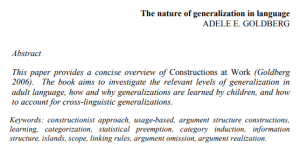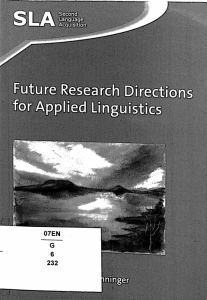The aim of this essay is to investigate what English teachers‟ attitudes are towards British English, American English and Mid-Atlantic English. What variety of English do teachers use in Swedish upper secondary schools today and what are their reasons for using that variety? Do upper secondary school teachers think it is important to expose students to several varieties of English and do they teach differences (e.g. vocabulary and spelling) between varieties? The material is based on a questionnaire, which 20 participating teachers from five different upper secondary schools in Gävleborg answered. The study showed that there is an even distribution between the varieties used and taught. British English was preferred by teachers working the longest time while both AmE and MAE seemed to be growing in popularity among the younger teachers. Of the 20 teachers, 18 considered teaching differences to students since it gives them a chance to communicate effectively with people from other English speaking countries.
The nature of generalization in language
PDF #96 – Adele E Goldberg – The nature of generalization in language

This paper provides a concise overview of Constructions at Work (Goldberg 2006). The book aims to investigate the relevant levels of generalization in adult language, how and why generalizations are learned by children, and how to account for cross-linguistic generalizations.
How do learners acquire generalizations such that they can produce an open-ended number of novel utterances based on a finite amount of input? Why are languages the way they are? In order to address these long-standing questions, many linguists with varying backgrounds have converged on several key insights that have given rise to a family of constructionist approaches. These approaches emphasize that speakers’ knowledge of language consists of systematic collections of form-function pairings that are learned on the basis of the language they hear around them. This simple idea is, to my mind, what sets constructionist approaches apart from traditional generative grammar. The learning of language is constrained by attentional biases, principles of cooperative communication, general processing demands, and processes of categorization.
The term constructionist is intended to evoke both the notion of “construction” and the notion that our knowledge of language is “constructed”
on the basis of the input together with general cognitive, pragmatic and processing constraints. It is intended to be a more inclusive term than Construction Grammar, as the latter is a particular instance of a constructionist approach.
After reading “The nature of generalization in language” you can check important issues for ESL teachers on the section PDFs and visit my channel by YouTube.
The trauma-informed wellness approach

Teachers who understand the trauma-informed, wellness approach can have a profound impact on adult students affected by trauma—loss, domestic violence, childhood abuse, racism, natural disaster, and ongoing poverty. Learn more about this topic by reading on Patch.
ELLs improve reading and writing skills

Are English language learners acquiring the skills necessary to become literate in the English language by the end of high school? National achievement data indicate that the answer is no. As a result, students who are ELLs will struggle to leverage reading and writing as threshold skills for college, career, and everyday life. Learn more about this topic by reading on SmartBrief.
Future Research on Applied Linguistics
PDF #95 – Pfenninger, Simone E. and Navracsics, Judith – Future Research Directions for Applied Linguistics

It is important to know what is the future research on applied linguistics. To the extent that this collection, as its title implies, offers a snapshot of future implications for applied linguistics, our intention is to contribute to the progress and academic development of this broad discipline.
You can check more on Applied Linguistics in this link, and I am discussing some of the topics of this site in my Youtube channel.
On feelings and endless search for our language
In what language do you feel? To put it differently, in what language are you spontaneously inclined to express your deepest feelings? I need not elaborate on the importance of these considerations in these times of mounting horror, anxiety and sorrow. Learn more about this topic by reading on the DailyNation.
Second and Foreign Language Learning and Teaching
PDF #94 – P Skehan – Second and Foreign Language Learning and Teaching, 2006, The Chinese Uni HK
A number of preliminaries are unavoidable here. There is the issue of a critical period for language, that is, a period during which acquisition is different from other learning processes.
A passion for literature and teaching

Sitting in Judy Oster’s classes feels like a homecoming for anyone who loves literature. Imagine reading, exploring and discussing Austen, Wharton, Faulkner, Camus, Oz, Roth, Dostoevsky, Shakespeare and more. Imagine delving into the art of reading poetry and listening to the elegance of Frost, Yeats, Dickinson, Hopkins, T.S. Eliot and others. Learn more about this topic by reading on JPost.
Language as a Mental Faculty Chomskys Progress
PDF #93 – P H Matthews – Language as a Mental Faculty Chomskys Progress
Noam Chomsky is at once a brilliant grammarian and an important philosopher of language. As a grammarian, he has had greater influence on our conception of English syntax, both of the nature of syntax and the nature of particular constructions, than any other scholar now living, and continues to display a remarkable ability to discover new problems and new generalizations that his predecessors had entirely failed to notice.
After reading “Learning an L2 in a troubled world” you can check important issues for ESL teachers on the section PDFs, and visit my YouTube channel.
Cloud Nine Education Group
Cloud Nine Education Group Ltd is part of a shift in the teaching of ESL (English as a second language) into the digital world with its cloud-based platform used as a tool by teachers in the classroom. The curriculum is technologically advanced to meet the needs of increasingly mobile students. Tablets replace textbooks and the course content includes instructional videos and internet links which learners use to supplement in-class studies.
Learn more about this topic by reading on ProactiveInvestors.
